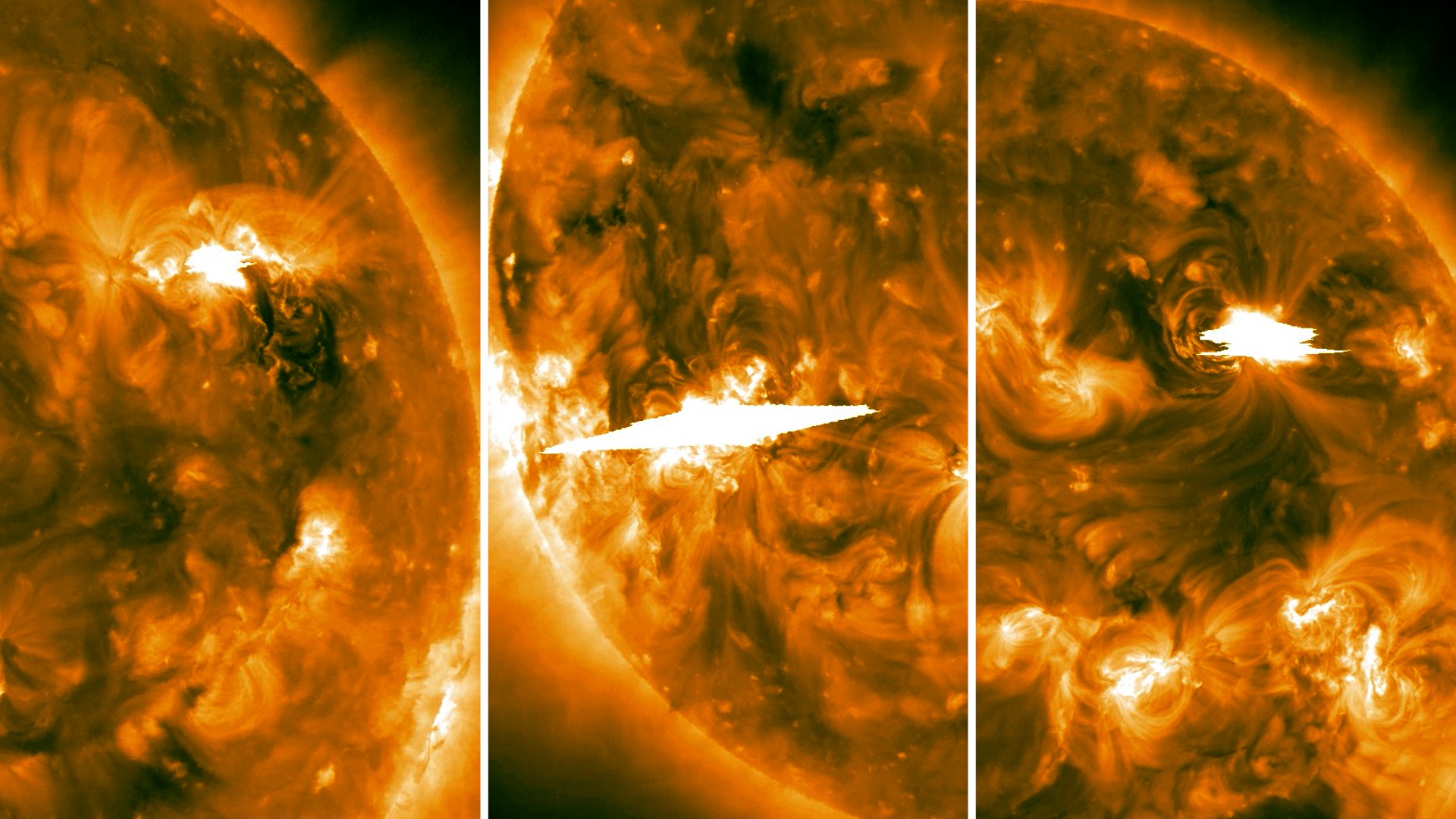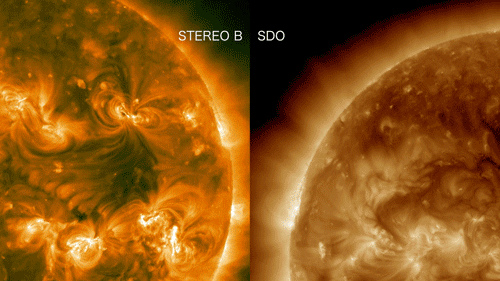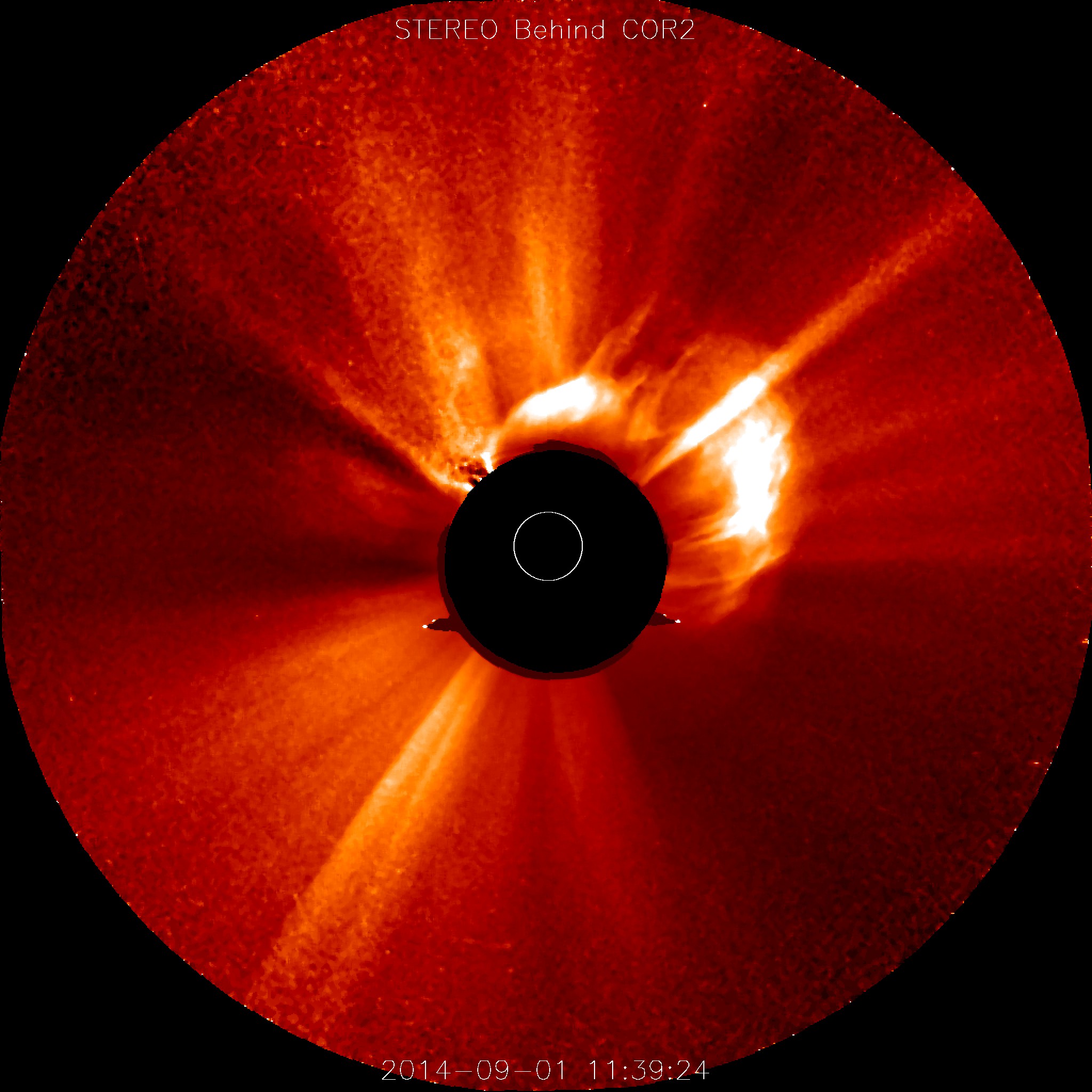Universe
ID: 12451
An international science team says NASA's Fermi Gamma-ray Space Telescope has observed high-energy light from solar eruptions located on the far side of the sun, which should block direct light from these events. This apparent paradox is providing solar scientists with a unique tool for exploring how charged particles are accelerated to nearly the speed of light and move across the sun during solar flares.
Fermi has seen gamma rays from the Earth-facing side of the sun, but the emission is produced by streams of particles blasted out of solar flares on the far side These particles must travel some 300,000 miles within about five minutes of the eruption to produce this light.
Fermi has doubled the number of these rare events, called behind-the-limb flares, since it began scanning the sky in 2008. Its Large Area Telescope (LAT) has captured gamma rays with energies reaching 3 billion electron volts, some 30 times greater than the most energetic light previously associated with these "hidden" flares.
Thanks to NASA's Solar Terrestrial Relations Observatory (STEREO) spacecraft, which were monitoring the solar far side when the eruptions occurred, the Fermi events mark the first time scientists have direct imaging of beyond-the-limb solar flares associated with high-energy gamma rays.
The hidden flares occurred Oct. 11, 2013, and Jan. 6 and Sept. 1, 2014. All three events were associated with fast coronal mass ejections (CMEs), where billion-ton clouds of solar plasma were launched into space. The CME from the most recent event was moving at nearly 5 million miles an hour as it left the sun. Researchers suspect particles accelerated at the leading edge of the CMEs were responsible for the gamma-ray emission.
Large magnetic field structures can connect the acceleration site with distant part of the solar surface. Because charged particles must remain attached to magnetic field lines, the research team thinks particles accelerated at the CME traveled to the sun's visible side along magnetic field lines connecting both locations. As the particles impacted the surface, they generated gamma-ray emission through a variety of processes. One prominent mechanism is thought to be proton collisions that result in a particle called a pion, which quickly decays into gamma rays.



Fermi Sees Gamma Rays from Far Side Solar Flares
Fermi has seen gamma rays from the Earth-facing side of the sun, but the emission is produced by streams of particles blasted out of solar flares on the far side These particles must travel some 300,000 miles within about five minutes of the eruption to produce this light.
Fermi has doubled the number of these rare events, called behind-the-limb flares, since it began scanning the sky in 2008. Its Large Area Telescope (LAT) has captured gamma rays with energies reaching 3 billion electron volts, some 30 times greater than the most energetic light previously associated with these "hidden" flares.
Thanks to NASA's Solar Terrestrial Relations Observatory (STEREO) spacecraft, which were monitoring the solar far side when the eruptions occurred, the Fermi events mark the first time scientists have direct imaging of beyond-the-limb solar flares associated with high-energy gamma rays.
The hidden flares occurred Oct. 11, 2013, and Jan. 6 and Sept. 1, 2014. All three events were associated with fast coronal mass ejections (CMEs), where billion-ton clouds of solar plasma were launched into space. The CME from the most recent event was moving at nearly 5 million miles an hour as it left the sun. Researchers suspect particles accelerated at the leading edge of the CMEs were responsible for the gamma-ray emission.
Large magnetic field structures can connect the acceleration site with distant part of the solar surface. Because charged particles must remain attached to magnetic field lines, the research team thinks particles accelerated at the CME traveled to the sun's visible side along magnetic field lines connecting both locations. As the particles impacted the surface, they generated gamma-ray emission through a variety of processes. One prominent mechanism is thought to be proton collisions that result in a particle called a pion, which quickly decays into gamma rays.



For More Information
Credits
Francis Reddy (Syneren Technologies): Lead Science Writer
Scott Wiessinger (USRA): Lead Producer
Tom Bridgman (Global Science and Technology, Inc.): Data Visualizer
Scott Wiessinger (USRA): Animator
Scott Wiessinger (USRA): Lead Producer
Tom Bridgman (Global Science and Technology, Inc.): Data Visualizer
Scott Wiessinger (USRA): Animator
Please give credit for this item to:
NASA's Goddard Space Flight Center. However, individual items should be credited as indicated above.
NASA's Goddard Space Flight Center. However, individual items should be credited as indicated above.
Short URL to share this page:
https://svs.gsfc.nasa.gov/12451
Mission:
Fermi Gamma-ray Space Telescope
This item is part of these series:
Narrated Movies
Astrophysics Features
Keywords:
SVS >> HDTV
SVS >> Music
GCMD >> Earth Science >> Spectral/Engineering >> Gamma Ray
GCMD >> Earth Science >> Sun-earth Interactions >> Solar Activity >> Solar Flares
SVS >> Astrophysics
SVS >> SDO
SVS >> Edited Feature
SVS >> Fermi
SVS >> STEREO
NASA Science >> Universe
GCMD keywords can be found on the Internet with the following citation: Olsen, L.M., G. Major, K. Shein, J. Scialdone, S. Ritz, T. Stevens, M. Morahan, A. Aleman, R. Vogel, S. Leicester, H. Weir, M. Meaux, S. Grebas, C.Solomon, M. Holland, T. Northcutt, R. A. Restrepo, R. Bilodeau, 2013. NASA/Global Change Master Directory (GCMD) Earth Science Keywords. Version 8.0.0.0.0
https://svs.gsfc.nasa.gov/12451
Mission:
Fermi Gamma-ray Space Telescope
This item is part of these series:
Narrated Movies
Astrophysics Features
Keywords:
SVS >> HDTV
SVS >> Music
GCMD >> Earth Science >> Spectral/Engineering >> Gamma Ray
GCMD >> Earth Science >> Sun-earth Interactions >> Solar Activity >> Solar Flares
SVS >> Astrophysics
SVS >> SDO
SVS >> Edited Feature
SVS >> Fermi
SVS >> STEREO
NASA Science >> Universe
GCMD keywords can be found on the Internet with the following citation: Olsen, L.M., G. Major, K. Shein, J. Scialdone, S. Ritz, T. Stevens, M. Morahan, A. Aleman, R. Vogel, S. Leicester, H. Weir, M. Meaux, S. Grebas, C.Solomon, M. Holland, T. Northcutt, R. A. Restrepo, R. Bilodeau, 2013. NASA/Global Change Master Directory (GCMD) Earth Science Keywords. Version 8.0.0.0.0











